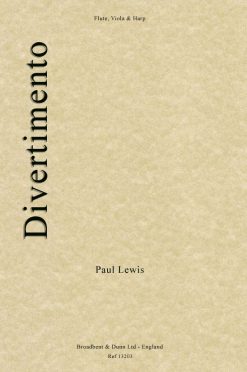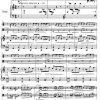£13.95
Piece Description
A happy work and full of Gallic charm. Many pieces for this combination are moody and introspective and so this can be a very good balancing work in a concert programme. It is fun to play and audiences love it. It is Paul Lewis’ most popular and often played chamber work, and has been broadcast on Classic FM Radio and performed in concert by many trios including the world famous Nash Ensemble. For teaching studios, schools, colleges, conservatories, libraries and professionals.
Review: “This is a very valuable addition to the limited but significant repertoire for flute, viola and harp trio. I have programmed it with Debussy’s sonata and it fits extremely well into concerts and well received. Technically challenging for all instruments and cleverly crafted together. The middle slow movement is typical of Paul Lewis’s charming middle movements, with a graceful melody appearing in all instruments in turn, before a final lively waltz movement incorporating flutter tonguing and changes of tempi.” – Dr. Rachel Smith DMA, MA, BMus (Hons), FTCL – October 2012
Review: “Debussy famously wrote about La Mer and visited Eastbourne. Along the coast in Brighton lives Paul Lewis, a friend of the trio and the composer who provided the encore, the second movement from his Divertimento. The title Love Song hides the fact that it was written in France, inspired by the composer’s love of that country. With its harmonious lyricism, reminiscent of Ravel’s Pavane it was a perfect and peaceful ending to a memorable and delightful concert.” – The Aurora Trio – November 2018
Review: “Brighton-born Paul Lewis can always be relied upon to deliver some delightfully scored music. The 1992 Divertimento is no exception. Every note exudes “Gallic charm and nonchalance.” It has been noted that many pieces for the flute/viola/harp combination can be rather “moody and introspective”, so this frothy, sunny and invariably happy music acts as a good balancing act in any recital programme. It has three attractive and well-balanced movements. The March is hardly military in tone; it evokes a gentle promenade in a French town. There is some lovely flutter tonguing on the flute here. The Love Song, despite the composer’s assurance that it is dedicated to family and friends, past, present and future, does really conjure up a little romance in some sequestered French village. Critics have seen hints of Ravel’s ubiquitous Pavane pour une infante défunte, but I just find it a lovely and romantic ‘hit’. The final Waltz is not meant to be danced to. It is a parody, and a highly successful one at that. As implied above, the entire composition is evocative of La Belle France, a place that Paul Lewis has a soft spot for. It is a Divertimento of great skill and invention. No wonder it is one of the composer’s most popular works.” – John France, MusicWeb International – September 2021
Additional information
| Media | |
|---|---|
| Composer | |
| Instrumentation | |
| Difficulty | |
| Series | |
| Movement Titles |
Biography
Biography
Lewis, Paul
Paul Lewis, born in 1943 in Brighton, England, has composed prolifically for British television since the age of 20, as well as producing a large body of tonal and melodic concert works. His TV scores for drama series such as Arthur of the Britons and The Prisoner of Zenda, children's series such as Seal Morning and Woof! and comedies such as Monty Python's Flying Circus and The Benny Hill Show have been heard all around the world. His instrumental works, several of which are in the U.K. exam syllabuses, are usually happy and romantic, inspired mostly by favourite places, close musician friends and loved ones. The Campion Cameo label has issued a CD of his TV themes, and his orchestral concert music appears on CD alongside the music of other English composers such as Arnold, Holst and Delius. Some of Paul's flute and harmonica works published by Broadbent & Dunn are also available on Campion Cameo. See www.paullewiscomposer.com for full details.

Related products
Flute, Viola & Harp



